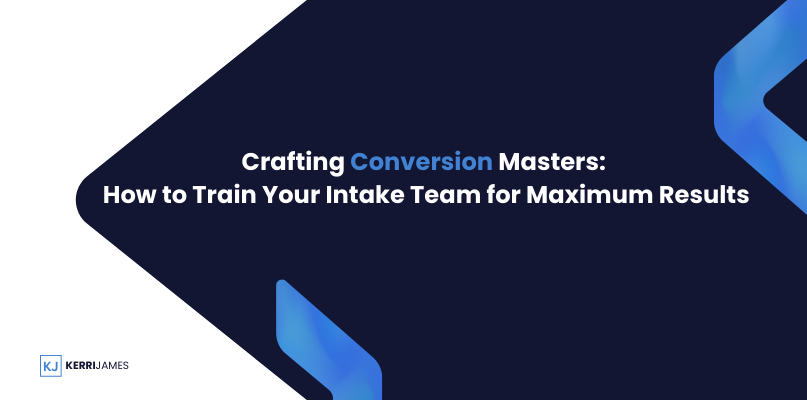Your intake team is the front line of your law firm, the welcoming voice that greets potential clients during their moment of need. They’re the first impression, the human connection that sets the tone for the entire client journey. In a competitive legal landscape, where every lead is a valuable opportunity, a well-trained intake team is your secret weapon, turning hesitant prospects into confident clients and driving your firm’s growth.
Think of it this way: Your intake team isn’t just answering phones; they’re conducting delicate negotiations, building relationships, and making split-second decisions that can make or break your firm’s success. Investing in their training isn’t just a good idea; it’s an essential strategy for maximizing conversions, enhancing client satisfaction, boosting efficiency, and ultimately, driving profitability.
This comprehensive guide delves into the key elements of creating a high-performing intake team, providing a roadmap for success from recruitment and training to ongoing development and performance measurement.
The Power of a Well-Trained Intake Team – Turning Leads into Loyal Clients
In the legal profession, where trust, empathy, and expertise are paramount, your intake team plays a pivotal role. They’re the first point of contact, the human face of your firm, responsible for guiding potential clients through a complex and often emotionally charged process. A well-trained intake team can:
- Capture More Leads: Making a Powerful First Impression: By quickly establishing rapport, actively listening to needs, and presenting your firm’s value proposition effectively, your intake team can capture more leads, converting those initial inquiries into meaningful conversations. They’re the gatekeepers, ensuring that only qualified leads progress through the funnel, saving your firm time and resources.
- Increase Conversion Rates: Guiding Clients Toward a Decision: Through skillful questioning, persuasive communication, and effective objection handling, your intake team can guide potential clients through the decision-making process, increasing the likelihood that they’ll choose your firm for their legal needs. They’re the bridge builders, connecting clients with the right legal solutions and fostering a sense of confidence and trust.
- Enhance Client Satisfaction: Setting the Stage for a Positive Experience: By providing a positive, empathetic, and efficient intake experience, your team sets the stage for a successful and satisfying client journey. They’re the first advocates, ensuring that clients feel heard, understood, and valued from the very beginning, building a foundation for a strong and lasting relationship.
- Boost Efficiency and Profitability: Streamlining Processes and Maximizing Resources: A well-trained intake team can streamline the entire client acquisition process, qualifying leads effectively, reducing wasted time on unqualified prospects, and freeing up your legal team to focus on what they do best – practicing law. They’re the efficiency experts, optimizing your operations and maximizing your firm’s profitability.
Investing in your intake team’s training is an investment in your firm’s future. It’s a strategic move that pays dividends in increased client acquisition, enhanced client satisfaction, and improved overall efficiency and profitability.
Section 1: Key Skills for a High-Performing Intake Team – The Art and Science of Client Conversion
A successful intake specialist is a unique blend of empathy, communication skills, sales acumen, and legal knowledge. They’re not just order-takers or appointment schedulers; they’re skilled communicators, problem solvers, and relationship builders who can navigate the complexities of client interactions with grace, finesse, and a genuine desire to help.
Here are the essential skills that every high-performing intake team should master:
- Empathy and Communication: Building Rapport and Trust from the First Interaction:
- Empathy – The Heart of Human Connection: Empathy is the ability to understand and share the feelings of another person. It’s about seeing the world through their eyes, feeling their emotions, and responding with compassion and understanding. In the context of legal intake, it’s about recognizing that potential clients are often calling from a place of vulnerability, fear, or confusion. They’re seeking guidance, reassurance, and a sense of hope.
- Active Listening – Going Beyond the Words: Active listening is the foundation of empathy. It’s about paying close attention to the client’s words, tone of voice, and emotions, and reflecting back their concerns to show that you’re truly listening and that you care about their situation. It’s about being fully present in the conversation, not just waiting for your turn to speak.
- Empathetic Language – Speaking to the Heart: Using phrases that acknowledge and validate the client’s feelings, such as “That sounds incredibly stressful,” “I can understand why you’re feeling overwhelmed,” or “We’re here to help you through this difficult time,” can create a powerful connection, building trust and rapport from the very beginning.
- Building Rapport – Creating a Genuine Connection: Beyond empathy and active listening, building rapport involves finding common ground, establishing a shared understanding, and making the client feel comfortable and at ease. This could involve mirroring their communication style, referencing something they mentioned during the conversation, or simply expressing genuine interest in their well-being.
- Active Listening and Questioning: Extracting Relevant Information and Identifying Needs
- Strategic Questioning – Unlocking the Client’s Story: Active listening goes beyond simply hearing the client’s words; it’s about actively engaging with their story, asking clarifying questions, and extracting the information needed to assess their legal needs, determine if your firm is the right fit, and guide them toward the best possible solution.
- Open-Ended Questions – Encouraging Exploration and Understanding: Open-ended questions encourage the client to share their story in their own words, providing valuable insights into their perspective, priorities, and emotional state. Instead of asking yes/no questions, use phrases like, “Can you tell me more about what happened?” or “How has this situation impacted your life?”
- Clarifying Questions – Ensuring Accuracy and Depth: Clarifying questions help ensure that you fully understand the client’s situation and gather all the necessary details. For example, “You mentioned that you were injured. Can you tell me more about the nature of your injuries and the treatment you’ve received?”
- Summarizing and Confirming – Demonstrating Understanding and Building Trust: Regularly summarize the key points of the client’s story, reflecting back their concerns and confirming your understanding. This shows that you’re paying attention, that you’ve grasped the nuances of their situation, and that you’re committed to providing accurate and effective legal representation.
- Sales Techniques: Persuasion, Addressing Objections, and Securing Commitments
- The Art of Persuasion – Presenting Your Value Proposition: While the legal profession is about providing legal services, client intake is fundamentally a sales process. Your intake team needs to be skilled in the art of persuasion, presenting your firm’s value proposition clearly, concisely, and persuasively. This involves highlighting your expertise, experience, success stories, and commitment to client satisfaction in a way that resonates with the potential client’s needs and motivations.
- Addressing Objections – Turning Concerns into Opportunities: Anticipate common client concerns, such as cost, timelines, uncertainty about the legal process, or past negative experiences with lawyers. Prepare persuasive responses that address those concerns directly and honestly, demonstrating empathy, offering solutions, and reinforcing your firm’s commitment to their well-being.
- Closing Techniques – Guiding Clients Toward a Decision: Use effective closing techniques, such as summarizing the benefits of working with your firm, offering a choice between options (e.g., scheduling a consultation or completing an intake form), or creating a sense of urgency (e.g., highlighting the importance of acting quickly to protect their rights), to encourage the client to commit to the next step.
Section 2: Developing a Call Path for Intake Success – A Structured Approach for Consistent Results
A structured call path provides your intake team with a roadmap for navigating client conversations, ensuring that they gather essential information, build rapport, present your firm’s value effectively, and guide the client towards a decision – all within a reasonable timeframe. It’s like a well-rehearsed dance, where every step flows seamlessly into the next, leading to a satisfying conclusion.
Key Stages of a Successful Intake Call Path:
- Introduction and Warm Welcome: Setting the Stage for a Positive Interaction: Start the call by introducing yourself by name, expressing gratitude for their call (“Thank you for calling [Firm Name]. I appreciate you reaching out.”), and setting a positive, empathetic, and professional tone. Let the client know that you’re there to help, that you’re ready to listen, and that their concerns are your priority.
- Screening and Qualification: Determining Fit and Efficiency: Ask targeted questions to determine if the client has a valid case, if their legal issue falls within your firm’s areas of expertise, and if they meet your minimum criteria for representation. This might include questions about the nature of their legal issue, the date of the incident, the parties involved, any injuries sustained, and their insurance coverage. Be upfront about the types of cases you handle and any limitations you might have, ensuring that you’re a good fit for their needs.
- Selling Your Firm’s Value Proposition – Showcasing Expertise and Building Confidence: Once you’ve determined that the client is a potential fit for your firm, showcase your strengths and demonstrate why you’re the best choice for their situation.
- Highlight your expertise: “We specialize in [area of law] and have a proven track record of success in cases like yours.”
- Emphasize your team’s experience: “Our attorneys have [number] years of experience and are dedicated to fighting for your rights.”
- Share relevant case successes: “We recently helped a client in a similar situation achieve a [positive outcome].”
- Articulate the benefits of choosing your firm: “We pride ourselves on clear communication, personalized attention, and aggressive representation.”
- Scheduling and Closing – Securing the Commitment and Moving Forward: If the client expresses interest in moving forward, guide them toward the next step in the process. This could involve:
- Scheduling a consultation with an attorney.
- Completing an online intake form to provide more detailed information.
- Signing an engagement letter to formalize the representation agreement.
Use effective closing techniques to encourage action and secure their commitment, creating a sense of momentum and reassuring them that they’ve made the right decision.
Benefits of a Structured Call Path:
- Consistency and Efficiency: A structured call path ensures that all intake specialists follow a consistent process, gathering essential information, presenting your firm’s value proposition in a clear and persuasive manner, and guiding clients toward a decision – all within a reasonable timeframe. This consistency improves efficiency, minimizes errors, and creates a more professional client experience.
- Improved Conversion Rates: A structured approach helps your team identify qualified leads quickly, target their communication effectively, address objections proactively, and guide clients toward a decision, ultimately increasing the likelihood of converting leads into paying clients.
- Enhanced Client Experience: A smooth, efficient, and empathetic intake process creates a positive first impression, instills confidence in your firm’s capabilities, and sets the stage for a positive and productive client relationship. It shows that you value their time, understand their needs, and are committed to providing exceptional service.
Section 3: Role-Playing and Ongoing Training – Sharpening Skills, Building Confidence, and Staying Ahead of the Curve
Training is not a one-time event; it’s an ongoing journey of continuous learning and improvement. The legal landscape is constantly evolving, as are client behaviors and expectations. To ensure that your intake team is equipped to handle the ever-changing demands of client interactions, a commitment to ongoing training and development is essential.
Using Role-Play to Practice Real Client Scenarios: Bridging the Gap Between Theory and Practice
Role-playing is a powerful tool for developing and refining intake skills, providing your team with a safe space to practice, experiment, and receive feedback. It allows them to:
- Practice Handling Different Client Personalities and Situations: From the anxious and emotional client to the skeptical and demanding client, role-playing exposes your team to a diverse range of personalities and situations they’ll encounter in real life. This prepares them to adapt their communication style, demonstrate empathy, and navigate challenging conversations with confidence.
- Test Different Communication Styles and Strategies: Encourage your team to experiment with different approaches to empathy, questioning, objection handling, and closing during role-playing exercises. This allows them to find the techniques that work best for their individual personalities and communication styles, making them more authentic and effective in real-life interactions.
- Receive Constructive Feedback and Coaching: Role-playing provides a valuable opportunity for constructive feedback and coaching. Observe your team members’ interactions, identify areas where they excel and areas where they could improve, and offer specific suggestions for refinement. This personalized feedback can help them hone their skills, build confidence, and develop a consistent and effective approach to client intake.
Continuous Training for Evolving Legal Trends and Client Behaviors: Staying Ahead of the Curve
- Stay Up-to-Date on Changes in the Law: The legal landscape is constantly shifting, with new laws, precedents, and regulations emerging regularly. Ensure that your intake team has access to the most up-to-date legal information, providing them with regular training sessions, access to legal databases, and opportunities to shadow attorneys or attend legal seminars.
- Adapt to Evolving Client Expectations: Client communication preferences are also evolving, with an increasing reliance on text messaging, online chat, video conferencing, and social media. Train your team on how to use these platforms effectively, ensuring that they can communicate with clients in a way that meets their expectations and preferences.
- Invest in Professional Development: Encourage your intake team to invest in their professional development by attending industry conferences, webinars, or workshops focused on client intake, communication skills, sales techniques, or legal technology. This ongoing investment demonstrates your commitment to their growth and helps them stay ahead of the curve in a constantly changing field.
Section 4: Measuring Performance and Offering Feedback – Data-Driven Insights for Continuous Improvement
Measuring your intake team’s performance isn’t about micromanaging or creating unnecessary pressure; it’s about providing a framework for growth, identifying areas for improvement, celebrating successes, and offering constructive feedback that helps your team reach their full potential. It’s about creating a culture of continuous learning and improvement, where data insights drive better results.
Key Metrics to Track: Measuring Efficiency, Effectiveness, and Client Satisfaction:
- Call Duration: Balancing Efficiency and Client Needs: Track the average length of intake calls to assess efficiency and effectiveness in gathering information and guiding the client towards a decision. While shorter calls are generally preferable, be mindful of the complexity of the legal issue and the client’s emotional state. A rushed call can be just as detrimental as an overly lengthy one.
- Conversion Rate: The Ultimate Measure of Success: The percentage of leads that convert into paying clients is the most important metric for measuring the overall success of your intake process. A high conversion rate indicates that your team is effectively qualifying leads, presenting your firm’s value proposition persuasively, and guiding clients toward a decision.
- Follow-Up Success: Nurturing Leads and Building Momentum: Track the percentage of leads who schedule a consultation or sign an engagement letter after the initial call. This metric indicates the effectiveness of your follow-up communication in maintaining engagement, building trust, and encouraging clients to take the next step.
- Client Satisfaction – The Voice of Your Clients: Gather feedback from clients about their intake experience, using surveys, online reviews, direct feedback forms, or personalized follow-up calls. This valuable insight can help you identify areas for improvement, address client concerns, and ensure that your team is consistently delivering exceptional service.
How to Provide Constructive Feedback and Coaching: Guiding Your Team Towards Excellence
- Focus on Specific Behaviors and Outcomes: Instead of offering vague critiques or generic praise, provide specific examples of what the team member did well and areas where they could improve. For example, “You did a great job using empathetic language to build rapport with the client, but I noticed you didn’t fully address their concern about the cost of legal representation. Let’s work on some strategies for handling that objection effectively.”
- Offer Actionable Suggestions: Provide clear and specific suggestions for improvement, such as practicing specific phrases, refining questioning techniques, or experimenting with different closing approaches. Role-playing can be an invaluable tool for practicing these suggestions and receiving feedback in a safe environment.
- Create a Culture of Continuous Learning: Encourage your intake team to embrace feedback as an opportunity for growth and development, not as criticism. Foster a team environment where open communication, constructive feedback, and a shared desire for excellence are valued and encouraged.
Final Words: Investing in Your Intake Team Is Investing in Your Firm’s Success
Your intake team is the engine that drives your firm’s growth, the heart of your client acquisition strategy. By investing in their training, providing them with the skills, tools, and support they need to excel, and fostering a culture of continuous learning and improvement; you’re creating a high-performing team that can maximize conversions, enhance client satisfaction, and ultimately, contribute to your firm’s long-term success.










